Flowers A - C
|
These pictures have all been taken in our garden over the years. Please let me know if I have labelled any of them incorrectly. Some of them will be duplicated where I know both the Latin and "common" name. Apologies for not knowing the exact details rather than the generics - a lot of the flowers were here when we arrived, some of the others were from "mixed" selections etc.
|
Yarrow (aka Achillea) is one of the taller perennials in our garden. We also have a smaller, purple variety that we imported from Gilda's garden a couple of years ago. It doesn't seem to self seed but spreads itself a little bit wider each year. It smells a bit funny when you walk past it and can be an irritant if you have sensitive skin - wear gloves if in doubt. |
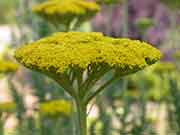
Achillea |
.jpg)
Aconite
|
Aconites (officially Winter Aconites or Eranthis Hyernalis) are wonderful as they show me that Spring is on the way. We have aconites in the front garden along with crocuses and loads of tulips (amongst others). They only grow a few inches tall but seem to me to be happy flowers. They also spread really well to fill in the gaps. |
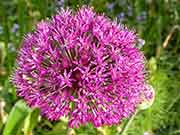
Allium
|
Alliums are one of Jonathon's favourite plants because of their structural nature - makes for good photos. One of our allium photos is used as the top of a bedside table in our guest room. We have a small bed of allium that bursts into life every May. Depending on the type, they can grow anything up to 3-4 feet tall. They are part of the onion family. |
|
.jpg)
Alstroemeria Orange Glory
|
We have two different sorts of Alstroemerias in the garden - both at the front of the house. The Orange Glory give a fantastic show of colour through the summer/autumn growing to about 3 foot high. Their sister flowers, the Princess Ragna variety, are much smaller and white with pink and yellow markings. We've been lucky the last few years as we've had two showings per season. Their "common" name is Peruvian Lillies. |
|
The Aquiliegia (aka Columbines) were here when we moved in and get on with life quite happily, popping up every year in their quiet corner. They haven't spread as much as I'd have liked but the ones that do grow are very pretty. They grow to about 3-4 feet high.
|
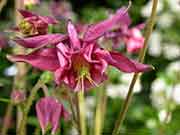
Aquilegia
|
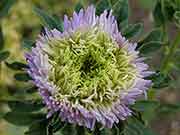
Aster
|
Another "happy" type of flower that adds a lot of colour to the garden. Part of the daisy family, asters come in all shapes and sizes. I've added a few extra pictures so you can get a feel for the variety. |
|
|
|
|
Aubretia has a home anywhere in our garden. It comes out in Spring and sets off the daffodils beautifully. It's really good ground cover, growing only a few inches high. We have a range of pink and purple colours to give a bit of variety.
|
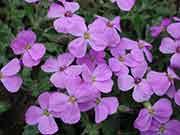
Aubretia
|
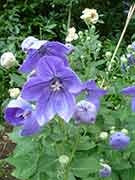 Balloon Flowers
Balloon Flowers |
Balloon flowers (Latin name - Platycodon Grandiflorus), so called as they look like balloons when they're in bud, come in both blue and white. They need staking but providing they're propped up well, they provide a long show of flowers through the summer months. They grow to about 2-3 feet high. |
There were quite a few Bluebells (Hyacinthoides non-scripta) when we moved in and they seem to have grown in number of their own free will. Again a flower that I really like (my favourite time for flowers is spring/early summer). A lot of the bluebells live in the allium bed but some are further afield. |
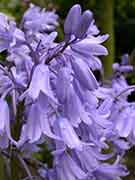 Bluebell
Bluebell
|
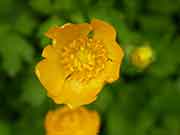 Buttercup
Buttercup
|
A lot of people see Buttercups (Ranunculus Acris) as weeds in a cultivated garden but I love the bright yellow. We have an area at the end of the garden where I let them grow to their heart's content (I pay for it by having to dig them out of other parts but it's worth it on balance!). |
.jpg) Camellia
Camellia
|
Of course, it's not just flowers per se that add colour to the garden but flowering shrubs as well. The Camellia is particularly welcome at the beginning of the year (the squirrels love to eat the middles from the flowers). |
The Ceanothus (California Lilac) brightens up its corner later in the season (generally around May). We also have a smaller bush in the gravel garden. |
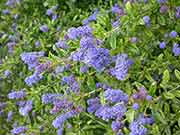 Ceanothus
Ceanothus |
|
Helleborus (aka Christmas Rose) - we have a couple of varieties in the garden and Jonathon's Mum gave us some hellebore plantlets last year that were too young to flower (she did warn us that they would be). They've bushed out really well through the summer so we're hoping they'll add to the show our existing plants give us in the first few months of the year.
|
.jpg)
Christmas Rose
|
.jpg)
Chrysanthemum
|
The chrysanthemum on the left is a shrub. We have several of these, all the same colour, at the front of the house. We did have yellow and white as well but they didn't survive the winter. This year we've introduced some taller, individual chrysanthemums into the garden and have been repaid with some lovely autumn colour. They don't seem to be in fashion at the moment but when you see a whole row of them on a cold, dull autumn day it can really cheer you up. |
Cistus, on the other hand, are definitely summer flowers. They love the sun and are lovely and bright. You would think that the bright pink outside and the equally bright yellow middle would clash but somehow, on this plant, they don't. |
 Cistus
Cistus
|
.jpg) Clematis
Clematis
|
Clematis can be found crawling along the fence between us and our neighbours and in pots climing up bamboo canes at the back of the house outside the dining room window. Their middles are fascinating and it's amazing how far/tall they can grow in one season. |
|
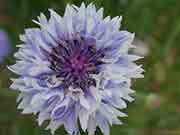 Cornflower
Cornflower
|
The Cornflower (Centaurea Cyanus) is another complex, multi-layered plant. I had no idea that they could come in colours other than blue until I started growing them a few years ago and a pink one or two popped up. They sway in the breeze, self seed a little bit and generally add interest to the garden. They grow to about 4 foot in our garden. An added benefit is that the bees love them. |
.jpg) Cosmos
Cosmos
|
When Tina, our friend from South Africa, visited and saw we were growing Cosmos she got quite excited but also a little bit home-sick. Apparently they grow as wild flowers in her part of the world. We were given some seeds one year by Helen and really enjoyed the grace of these flowers. As you can see, we had both pinks and whites. They flower late in the season but you have the benefit of their lacy foliage until the flowers come. Again, they need staking if it's windy (which it usually is here). |
| |
|
|
We have crocuses all over the garden, front and back, which leads to an ongoing battle with the squirrels who seem to really enjoy the corms. The colours we have range from white through yellow/orange and purple so they provide small clusters of different colours in the spring time. |
.jpg) Crocus
Crocus
|
|
To view the other pages, please click on the relevant letter selection below. |
|
|
|
|

.jpg)

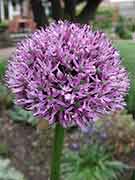
.jpg)


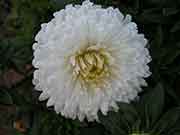
.jpg)
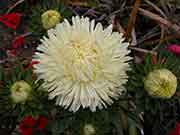




.jpg)

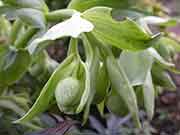
.jpg)
.jpg)

.jpg)
.jpg)

.jpg)
.jpg)
.jpg)
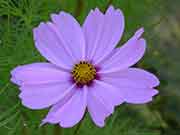
.jpg)